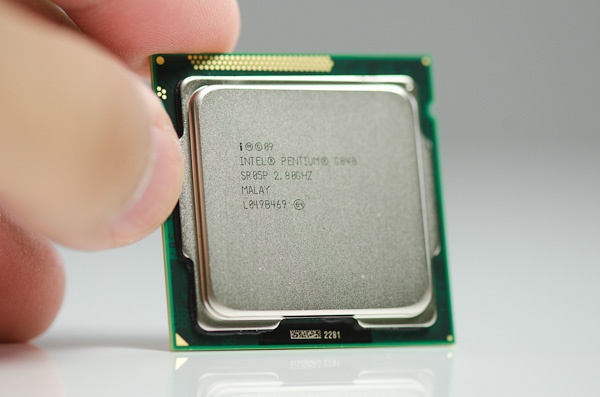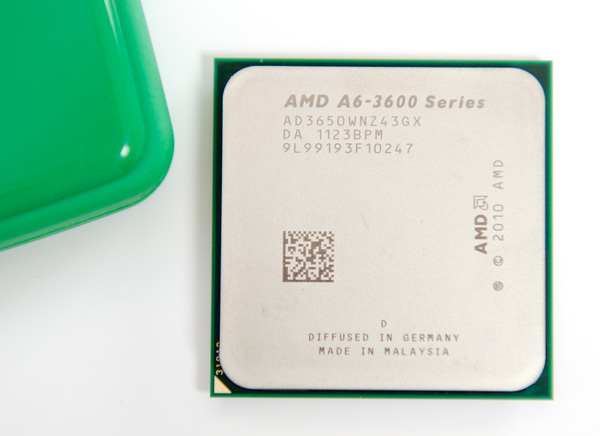The Sandy Bridge Pentium Review: G850, G840, G620 & G620T Tested
by Anand Lal Shimpi on August 23, 2011 12:11 AM ESTFinal Words
Despite boasting Intel's latest Sandy Bridge microarchitecture, the conclusions here are pretty much unchanged from the past. Intel maintains an advantage when it goes up against an AMD chip with the same number of cores, almost regardless of clock speed. In the case of the Pentium G620, even an Athlon II X2 265 with a 27% clock speed advantage can't outperform the Sandy Bridge based CPU. If you're choosing between chips with the same number of cores at the same price, Intel wins.
The decision tilts in AMD's favor if you start comparing to the Athlon II X3. In heavily threaded workloads, the Athlon II X3's third core helps put it ahead of the entire SNB Pentium lineup. If you're building a machine to do offline 3D rendering, multithreaded compiling or video transcoding then AMD continues to deliver the best performance per dollar. It's in the lighter, less threaded workloads that the Pentium pulls ahead. If you're building more of a general use system (email, web browsing, typical office applications and even discrete GPU gaming), the Pentium will likely deliver better performance thanks to its ILP advantages. What AMD has offered these past couple of years is an affordable way to get great multithreaded performance for those applications that need it.
Unfortunately the entire Sandy Bridge Pentium lineup is clock locked. Without turbo modes there's no support for overclocking at all. While these new Pentiums would have normally been great for enthusiasts looking to overclock, Intel has ensured that anyone looking to get more performance for free at the low end will have to shop AMD. Unfortunately Intel's advantage in single/lightly threaded performance is big enough that a clock speed advantage alone is generally not enough to make up for it (see G620 vs. Athlon II X2 265 comparison). It's sad that it has come to this. I was hoping we'd see more K-series SKUs at the low end but it seems like those will only be for the enthusiasts at the high end.
The Pentium's on-die GPU isn't particularly impressive. It's the HD Graphics 2000 from the rest of the Sandy Bridge lineup without Quick Sync or any of the extra video features. I am particularly sad that Quick Sync is missing as it would've made these Pentiums extremely attractive for users that do a lot of video transcoding. Thankfully video decode acceleration and HD audio bitstreaming support remain, so if you're looking to build a cheap Sandy Bridge based HTPC and don't care about the frills these chips will work just fine.
However, if you're building a system to do any sort of 3D gaming you're much better off either springing for a cheap discrete card or looking at AMD's A6-3650 if you want to stay integrated. Although you can play older titles at low resolution on the Pentium's on-board GPU, you'll have a much better experience with a discrete GPU or with the A6.
It all boils down to this. If you want a good, cheap, general purpose PC then the Pentium G620 seems competent and cheap. You can consider the G840 if you want a bit more performance. If you do a lot of threaded work (e.g. offline 3D rendering) the next step up is the Athlon II X3 455. If you do any amount of consumer level video transcoding using apps that are Quick Sync enabled, opt for the Core i3 2100 instead. If gaming is important to you then either buy a discrete GPU or look to AMD's Llano.
As far as AMD's A6 vs. A8 goes, the A8-3850 only commands a $20 price premium over the A6-3650. That $20 gives you another 8 - 10% on the CPU side and around 20% on the GPU. In my opinion, if you're considering a Llano system - spring for the A8.












110 Comments
View All Comments
yankeeDDL - Tuesday, August 23, 2011 - link
If you want to use a "super duper" cheap PC you use Llano, not a Pentium.ET - Tuesday, August 23, 2011 - link
What's apparent from your response is that Llano can beat a Pentium only when you make sure to ignore the requirements and instead stick to a couple of words without true meaning.yankeeDDL - Tuesday, August 23, 2011 - link
The details of the "super duper" were in the post I replied to, which I was obviously referring to.I intentionally put "super duper" in quotes, as it seemed a rather inefficient way to convey its message.
I stick to what I said though: if you need a small system with some power to get your everyday job done, you should look for something that gives you the best value for your bucks, as well as the lowest acceptable level of performance.
Hey, we're reviewing the Pentium family here: anybody interested in gaming machines, or high-performance PCs, should look elsewhere.
If you look at Pentium, is because you seek entry level, unpretentious performance.
And my point is that Llano is a much better alternative than the Pentiums in these areas: they have slightly less performing CPU cores, much better GPU (which, let's not forget, helps an awful lot in web browsing, Flash acceleration) and all for a similar price.
jabber - Tuesday, August 23, 2011 - link
The issue I find when trying to build a budget Intel box over a budget AMD box is not so much the CPUs (though often I find the Intel chip will come in around £15 more) but the motherboards.I can get a decent Gigabyte motherboard for the AMD chip with USB3.0/eSATA/HDMI/Firewire/optical out etc.
The same cost Intel board will still have serial and parallel ports and maybe 4 USB2.0 ports and thats pretty much it.
Intel at the budget end just isnt attractive or value for money. Oh it might be a bit faster but Joe Customer doesnt notice that.
Intel - Nice CPUS, shame about the crappy motherboard choices.
yankeeDDL - Tuesday, August 23, 2011 - link
From the moment that the 1st Athlon arrived, Intel stopped making sense for budget PCs.It is very clear today: Sandy Bridge is the undisputed champion of performance and efficiency, only clouded by a mediocre GPU, and yet, despite the significant architectural advantage, they compete with AMD's pricing by crippling their CPUs to the level where it makes no sense anymore.
Unless you're an Intel fanboy/aficionado, like ET, it should be clear to you that the efficiency advantage of a dual core Pentium G620, over an Athlon II X3, are easily balanced by performance advantage (Tom's Hardware places the Athlon II X3 au-pair with the G850). When compared to the G850, you have higher cost, less flexibility, and 2 cores instead of 3. Quite frankly, I'm still waiting for a good benchmarking methodology, that shows how much CPU cores the various background programs (virus scanners, power management, instant messaging, live feeds, ...) take on a regular basis and what real-life impact do they have on a 2-core vs 3-or-more-core CPU.
seapeople - Tuesday, August 23, 2011 - link
I don't see why everyone is so negative about Intel "crippling" their CPUs to sell them at lower prices. Sure, Intel could just sell their 2600K for $100 and still make a profit, but that would basically drive AMD out of business and then our government would step in and then we would have Intel Company A and Intel Company B. Company B would buy the remnants of AMD and then we would have Intel and Pseudo-AMD Intel.How would that be better?
yankeeDDL - Wednesday, August 24, 2011 - link
The fact is crippling their CPUs doesn't really save them any money, since the silicon is very likely exactly the same.The gripe, at least from my side, is that you need a degree to figure out what does what.
And yes, Intel has enough money to throw AMD out of business any time they want to, which is also why it bothers me that people try to look for value in low-performance, crippled Intel units, when they have better solutions on AMD's front: if you don't find this info on specialized, semi-professional websites like Anandtech, then where can you?
Let's not forget what was happening with Pentium II and Pentium 4 back then when Intel had, basically, no competition. I am convinced that we have Sandy Bridge today (which is a fantastic piece of technology), only thanks to the kick in the balls that AMD gave Intel with the Athlon back in the days.
I hope history repeats itself with Bulldozer: it is only going to do all of us customers, good.
CeriseCogburn - Monday, June 25, 2012 - link
For all you know without AMD sucking dry the world's resources and crapping up everything with endless complaints, lawsuits, appeals to world courts and the EU, spending hundreds of millions fragmenting the PC space and wasting dies on crap, we'd have INTEL CPU's at twice and thrice the speed they are now.Instead Intel has had to spend vast resources coddling the crybaby amd and billions in court, constant engineers to help the crybaby loser company do x86 compatibly, and on and on.
AMD is much more likely a SCOURGE to progress and innovation - and now after sucking the world dry, they are still worse than broke.
CeriseCogburn - Monday, June 25, 2012 - link
It is clear that NONE of you people have clue one what Intel makes on any cpu.The saddest of issues is amd LOSES MONEY on everything they make.
Now, since every one of you Intel haterz tells us amd is such a good deal, isn't it YOU who need to change ? Aren't you people the real problem ?
AMD should charge more, and all you amd fanboys SHOULD BUY IT when it is no better a deal than any Intel - then we could have TWO competitors, one of which is no longer losing it's shirt.
Instead I'm sure you'll keep demanding amd strip their prices ever lower, THEN THEY WILL GO OUT OF BUSINESS - and you'll blame Intel, or the government, but NEVER you, never yourselves, never the REAL PROBLEM.
yo2020 - Tuesday, August 23, 2011 - link
It would be great if we have a chart for Power Consumption without discrete GPU.